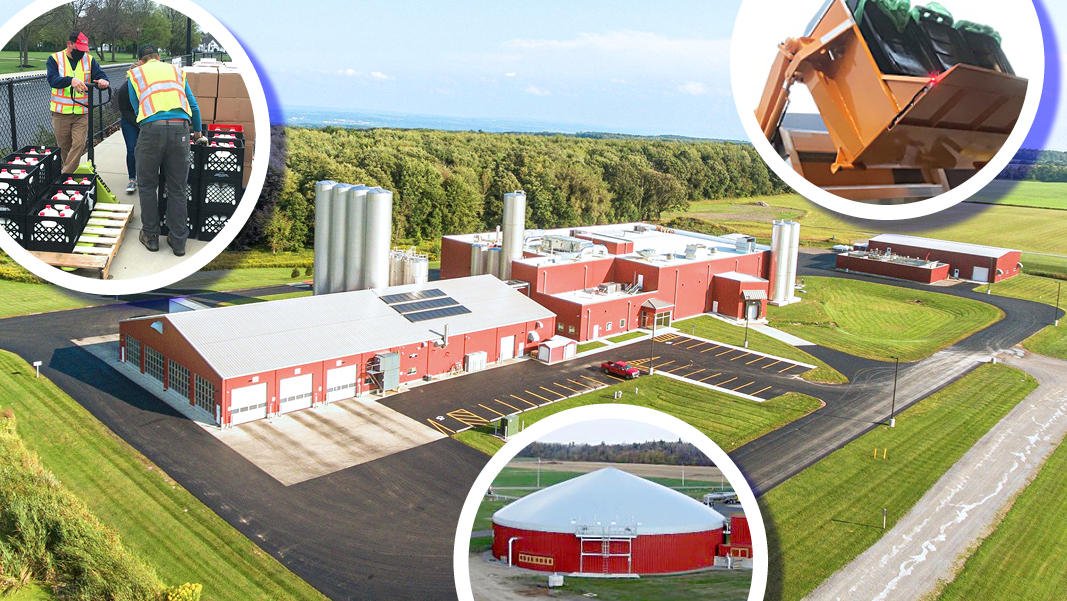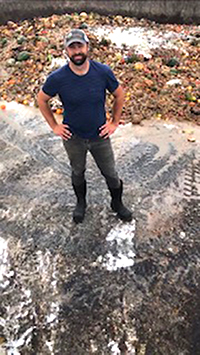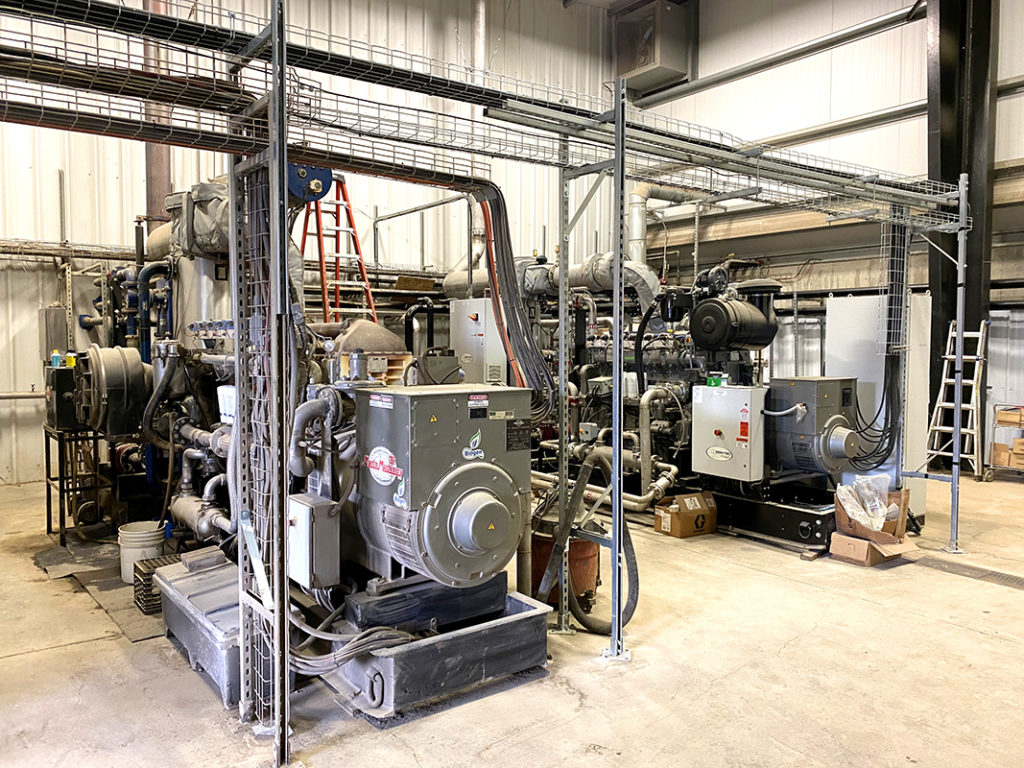Top: Craigs Station Creamery (center) pipes its high strength wastewater to the neighboring Noblehurst Green Energy digester (bottom). Natural Upcycling collects food waste (upper right), a portion of which is processed at the digester. The Creamery and Natural Upcycling teamed up to rescue surplus milk for distribution during the pandemic (upper left).
Nora Goldstein
Chris Noble is a seventh generation dairy farmer in Linwood, New York, in the western part of the state. His family’s company, Noblehurst Farms, Inc., has a herd size of about 1,850 dairy cows. “We are in the process of switching our herd from Holsteins to Jerseys, which are smaller framed cows that produce less milk, but the milk they produce is richer — about 20% to 30% butterfat and protein,” explains Noble. “They are also more feed efficient, and with land prices in this area, we are mindful of efficiency in terms of optimizing use of the feed that we grow.”
In 2001, Noblehurst Farms began construction of an anaerobic digester, one of the first on a dairy farm in New York state. It started taking high strength food waste several years later, primarily from local food manufacturers. In 2014, with an increasing flow of preconsumer food waste from grocery stores and other generators in the area, Noblehurst replaced the original plug flow digester with a complete mix system designed by EnviTec-Biogas USA that features a 1.34 million-gallon tank. The anaerobic digester is designed to process up to 250 tons of influent on a daily basis. The digester and electricity sales are managed by a separate company, Noblehurst Green Energy. The company has two Guascor/Siemens combined heat and power engines, installing the second one this past winter for a total electrical generation capacity of nearly 800 kW.
Craigs Station Creamery, a milk processing facility that is a joint venture of eight family-run farms (including Noblehurst) and Dairy Farmers of America, is located on a property near the digester complex. Its whey and process wastewater are piped from the Creamery to a receiving tank at the digester. The creamery uses electricity from Noblehurst Green Energy. It also added a cheese processing facility in 2018, increasing the wastewater flow to the digester and its demand for energy. “The digester always produced a good amount of biogas, which was used by our farm and the creamery, with the excess fed via a net metering arrangement with National Grid,” says Noble. “We are not islanded — when the grid shuts down we shut down. At the end of the month National Grid sends us a statement that indicates whether we needed to purchase additional power or credit us for power that we sold to the grid.”
Natural Upcycling
Recognizing the benefits of codigesting food waste with dairy manure — revenues from tip fees, increased biogas production and thus increased electricity generation — Noblehurst formed a new organics collection company in 2014, Natural Upcycling, with Harry Cohen, a food waste hauler, who was originally servicing six Wegmans supermarkets in the area. Noble and Cohen saw the opportunity to partner together and provide a suite of food waste management services, including hauling, depackaging, recycling, composting and anaerobic digestion, to customers in New York State. The service area was about a 100-mile radius from the farm. When BioCycle featured Natural Upcycling in 2017, the company was collecting and processing about 200 tons/week, with about 75 tons/week being digested at Noblehurst Farms.
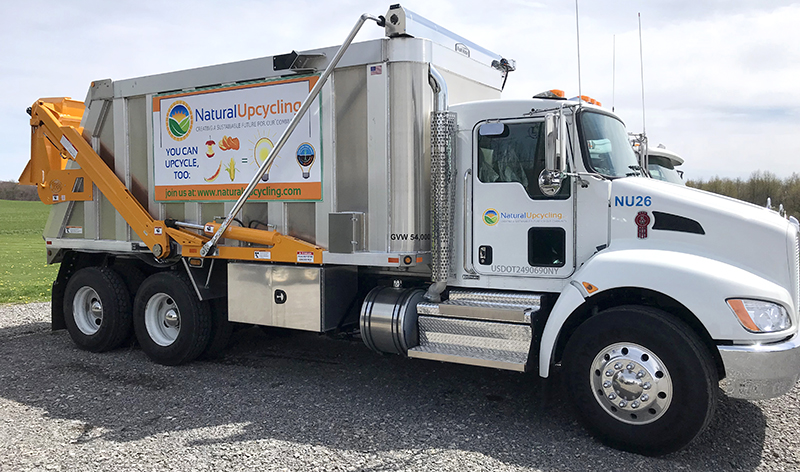
Natural Upcycling, an organics collection service, operates in 7 states in the Northeast and Mid-Atlantic.
Today, Natural Upcycling operates in 7 states in the Northeast and Mid-Atlantic: New York, Massachusetts, New Jersey, Pennsylvania, Delaware, Virginia, and Maryland as well as in the District of Columbia. The company has a fleet of 15 vehicles, most of them rear-loading, 15-foot long, 10-foot high collection trucks with bodies manufactured by Brown Industrial. It brings the collected organics to composting and/or anaerobic digestion facilities that are in the areas being serviced. Natural Upcycling collects upwards of 100,000 tons/year of food waste. Overall, about 75% of the food waste collected and/or processed is recycled via anaerobic digestion and about 25% is composted, fed to animals, or land applied.
Natural Upcycling also services food donation programs, e.g., transporting nonperishable edible food to distribution centers and food banks. Last spring, as the pandemic was wreaking havoc on food distribution supply channels, the company became directly involved with food rescue. “In April 2020, as dairy farmers, we saw a lot of milk being dumped,” says Noble. “We applied for a grant from ReFED’s COVID-19 Food Waste Solutions Fund, and worked with Dairy Farmers of America to process over 25,000 gallons of excess milk into whole milk gallons, which were distributed over the course of two months to food banks. We collaborated with Craigs Station Creamery and Pittsford Farms Dairy. In June 2020, we participated in a drive-through milk giveaway event with our county’s [Livingston] Farm Bureau. More than 1,100 gallons of milk were distributed at that event.”
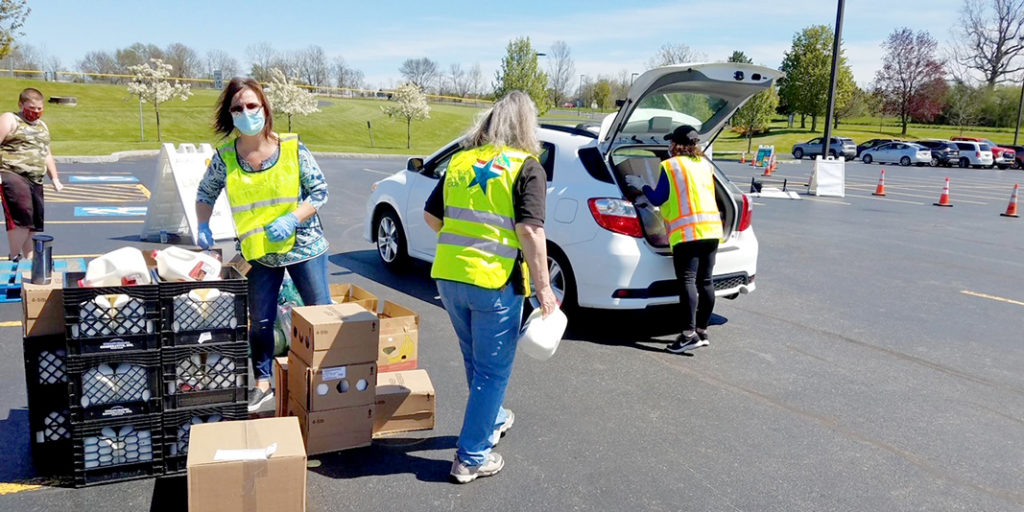
Surplus milk that was being dumped due to the pandemic was rescued and bottled via a collaboration between Natural Upcycling, Craigs Station Creamery and Pittsford Dairy. In June 2020, more than 1,100 gallons of the rescued milk were distributed at a drive-through event. Photos courtesy of Natural Upcycling
Natural Upcycling also partnered with fellow ReFED Fund grantee FarmLink to amplify milk donation. They collected and processed 4,000 gallons of milk, which were hauled to the River Fund in New York City. FarmLink donated 2,000 gallons and the trucking, which Natural Upcycling matched. Natural Upcycling continues to prioritize and spearhead food donation efforts as a preferable means to recycle food waste, in keeping with the U.S. EPA’s Food Recovery Hierarchy.
Preprocessing Food Waste At Noblehurst
Food waste arrives at Noblehurst Green Energy in three forms: Liquid, preconsumer food waste from the creamery and other food manufacturers (e.g., yogurt plant, brewery); source separated organics that Natural Upcycling collects from commercial and institutional generators; and packaged food waste that requires several processing steps. “Overall, we probably receive about 100 tons/day of food waste streams,” notes Noble. “To accomplish our depackaging step, we hire workers through the Finger Lakes Developmental Disabilities Service Office. They open the packages, remove the contents, and sort them by packaging commodity type, e.g., aluminum, PET, metal, cardboard. That significantly increases the recyclability of those commodities after depackaging.”
The facility uses a small machine equipped with an auger to depackage the products. The unit has the capacity to process about 25 tons/day. “Our goal was to install a machine with a very low impact crushing mechanism so the packaging doesn’t get beat up and require additional screens to capture small particles,” he adds. “We cannot feed contamination into our digester system, nor utilize digestate with any contamination. Ultimately, since we are limited on throughput due to our unique process, we are limited in what we can run through this system. Our goal is to prioritize larger format packaged items containing liquids through the depackager.” The source separated organics delivered by Natural Upcycling are conveyed into a Vogelsang X-Ripper, where they are pulped and mixed with the liquid food waste and manure.
Digester Operations
Manure from Noblehurst Farms is scraped from the barns into a below-grade channel that flows to a 28,000-gallon collection pit. The efficiency of the complete mix AD technology and the addition of sometimes watery food waste results in a very low solids content digestate (1-2% solids), which made it costly to recover digested solids to use as bedding for the dairy cows. As a result, Noblehurst Farms has been purchasing bedding since installing the Envitec system.
Until last year, liquid effluent from the anaerobic digester was mixed into the manure collection pit to create a slurry that was pumped to the anaerobic digester’s mixing room.
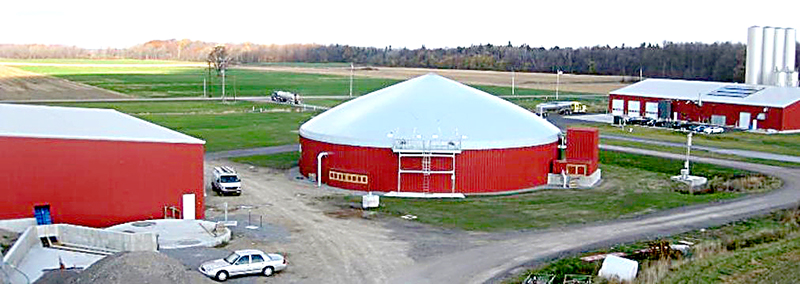
In 2014, Noblehurst Green Energy installed a 1.34 million gallon complete mix system anaerobic digester designed by EnviTec-Biogas USA.
In 2020, Noblehurst modified operations to recover solids from the manure before the digestion step, and thus stopped mixing in the effluent. “We installed three Bauer separators to press the solids out of the manure, which is 8% to 10% solids,” explains Noble. “The new system was a big investment, but the payback is not having to purchase bedding. It is critical to use the raw separated solids [bedding] within 24 hours to avoid pathogen growth.”
The feedstock mix going into the digester is roughly 60% manure and 40% food waste. Retention time in the digester is around 25 days. Biogas generation is 432,000 cubic feet/day. Hydrogen sulfide is scrubbed from the biogas within the anaerobic digester by injecting ambient air into the headspace of the digester. After hydrogen sulfide abatement, the biogas cools as it is pumped to the Guascor/Siemens engines. Heat from the engines is captured and used to heat the digester and associated rooms.
Noblehurst’s total investment since 2014, including the manure solids separation and second engine, is approximately $5 million. More details on the anaerobic digester, materials flow, economics and financing can be found in a 2016 case study.
Ban On The Horizon
New York State’s Food Donation and Food Scraps Recycling Law becomes effective on January 1, 2022. Business that generate an annual average of 2 tons/week or more of wasted food are required to donate excess edible food, and recycle all remaining food scraps if they are within 25 miles of an organics recycler (composting facility, anaerobic digester, etc.). The proposed regulations to implement the law (comment period ends April 27) also include food waste depackaging facilities that are within 25 miles of a generator.
“In the aggregate, I don’t think New York State has enough infrastructure at this time to manage the food waste required to be recycled,” notes Noble. “There are definitely pockets of the state with adequate infrastructure, but in general, not enough. One key to compliance is collection, and Natural Upcycling is equipped to meet that demand. However it is critical to address contamination when making the shift from landfill to increased donation and recycling. From an agricultural perspective, we would love for the industry to evolve where it values clean organics. Ultimately, haulers can be powerful in that space — playing a frontline role in incentivizing food rescue and source separation into clean organics streams.”


